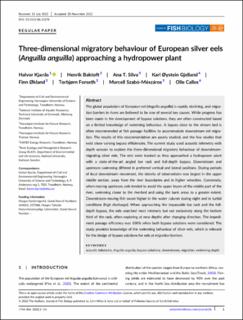| dc.contributor.author | Kjærås, Halvor | |
| dc.contributor.author | Baktoft, Henrik | |
| dc.contributor.author | Silva, Ana T. | |
| dc.contributor.author | Gjelland, Karl Øystein | |
| dc.contributor.author | Økland, Finn | |
| dc.contributor.author | Forseth, Torbjørn | |
| dc.contributor.author | Szabo-Meszaros, Marcell | |
| dc.contributor.author | Calles, Olle | |
| dc.date.accessioned | 2023-02-09T13:20:19Z | |
| dc.date.available | 2023-02-09T13:20:19Z | |
| dc.date.created | 2022-12-12T11:32:33Z | |
| dc.date.issued | 2022 | |
| dc.identifier.citation | Journal of Fish Biology. 2022, . | en_US |
| dc.identifier.issn | 0022-1112 | |
| dc.identifier.uri | https://hdl.handle.net/11250/3049760 | |
| dc.description.abstract | Three-dimensional migratory behaviour of European silver eels (Anguilla anguilla) approaching a hydropower plant facilities to accomodate downstream eel migration. The results of this recommendation are poorly studied, and the few studies that exist show varying bypass efficiencies. The current study used acoustic telemetry with depth sensors to explore the three‐dimensional migratory behaviour of downstream‐migrating silver eels. The eels were tracked as they approached a hydropower plant with a state‐of‐the‐art angled bar rack and full‐depth bypass. Downstream and upstream swimming differed in preferred vertical and lateral positions. During periods of local downstream movement, the density of observations was largest in the upper middle section, away from the river boundaries and in higher velocities. Conversely, when moving upstream, eels tended to avoid the upper layers of the middle part of the river, swimming closer to the riverbed and using the bank areas to a greater extent. Downstream‐moving fish swam higher in the water column during night and in turbid conditions (high discharge). When approaching the impassable bar rack and the full‐depth bypass, the eels searched most intensely but not exclusively along the bottom third of the rack, often exploring at new depths after changing direction. The impediment passage efficiency was 100% when both bypass solutions were considered. The study provides knowledge of the swimming behaviour of silver eels, which is relevant for the design of bypass solutions for eels at migration barriers. | en_US |
| dc.description.abstract | Three-dimensional migratory behaviour of European silver eels (Anguilla anguilla) approaching a hydropower plant | en_US |
| dc.language.iso | eng | en_US |
| dc.publisher | Wiley | en_US |
| dc.rights | Navngivelse 4.0 Internasjonal | * |
| dc.rights.uri | http://creativecommons.org/licenses/by/4.0/deed.no | * |
| dc.subject | Fish behaviour | en_US |
| dc.subject | Fiskeadferd | en_US |
| dc.subject | Akustisk telemetri | en_US |
| dc.subject | Acoustic telemetry | en_US |
| dc.subject | Fiskepassasje | en_US |
| dc.subject | Fish passage | en_US |
| dc.title | Three-dimensional migratory behaviour of European silver eels (Anguilla anguilla) approaching a hydropower plant | en_US |
| dc.title.alternative | Three-dimensional migratory behaviour of European silver eels (Anguilla anguilla) approaching a hydropower plant | en_US |
| dc.type | Peer reviewed | en_US |
| dc.type | Journal article | en_US |
| dc.description.version | publishedVersion | en_US |
| dc.source.pagenumber | 14 | en_US |
| dc.source.journal | Journal of Fish Biology | en_US |
| dc.identifier.doi | 10.1111/jfb.15278 | |
| dc.identifier.cristin | 2091847 | |
| dc.relation.project | Norges teknisk-naturvitenskapelige universitet: Halvor Kjærås | en_US |
| dc.relation.project | Norges forskningsråd: 257588 | en_US |
| dc.relation.project | Norges forskningsråd: 244022 | en_US |
| cristin.ispublished | true | |
| cristin.fulltext | original | |
| cristin.qualitycode | 1 | |

